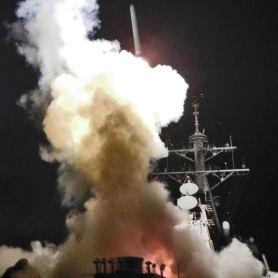Libya: Arab League condemns ‘bombardment of civilians’
Missile and air strikes against Gaddafi’s forces in Libya are hailed a success by the west, but the Arab League chief has condemned the “bombardment of civilians”.
RAF Tornado jets have joined international forces in Libya to attack Muammar Gaddafi’s military.
Missiles targeted radar systems and ground-to-air missile sites around the cities of Tripoli and Misrata
The Ministry of Defence confirmed Stormshadow missiles were launched from Tornado GR4 fast jets, which flew 3,000 miles from RAF Marham in Norfolk and back.
LIVE BLOG: Libya - Operation Odyssey dawn
A Royal Navy Trafalgar-class submarine stationed in the Mediterranean took part in the co-ordinated assault, which also involved forces from the US, France, Italy and Canada under the operational control of US Africa Command.
International controversy
Sixty-four people were killed in the western bombardment, a Libyan government health official said, but it is impossible to verify the figures.
Arab League chief Amr Moussa called for an emergency meeting of the group of 22 states to discuss Libya. He requested a report into the bombardment which he said had “led to the deaths and injuries of many Libyan civilians”.
“What is happening in Libya differs from the aim of imposing a no-fly zone, and what we want is the protection of civilians and not the bombardment of more civilians,” Egypt’s official state news agency quoted Moussa as saying.
Arab backing for a no-fly zone provided crucial underpinning for the passage of the U.N. Security Council resolution last week that paved the way for Western action to stop Gaddafi killing civilians as he fights an uprising against his rule.
Colonel Gaddafi said the air raids amounted to terrorism.
He told state TV: “We will not leave our land and we will liberate it.”

International community ‘won’t stand by’
Defence Secretary Liam Fox said: “The fast jets flew 3,000 miles from RAF Marham and back, making this the longest range bombing mission conducted by the RAF since the Falklands conflict.
“This operation was supported by VC10 and Tristar air-to-air refuelling aircraft as well as E3D Sentry and Sentinel surveillance aircraft.”
Dr Fox said HMS Westminster was off the coast of Libya, and HMS Cumberland was in the region ready to support operations. Typhoon aircraft were also standing by to provide support.
He added: “Our capable and adaptable armed forces are once again displaying their courage and professionalism. This action has provided a strong signal – the international community will not stand by while the Libyan people suffer under the Gaddafi regime.”
The onslaught on Gaddafi came after an emergency summit in Paris agreed military action to enforce United Nations resolution 1973, which authorised “any necessary measures” short of foreign occupation to defend Libyan civilians.
Around 20 French Mirage and Rafale fighter jets were immediately sent into action over the rebel stronghold of Benghazi, firing the first shots of the operation to destroy a number of Gaddafi’s tanks and armoured vehicles.
Benghazi had come under fierce attack during the day, despite a supposed ceasefire, raising fears that Gaddafi would take advantage of delays in the international response to smash the opposition and commit atrocities against those who rose up against his 42-year rule a month ago.
President Barack Obama, making a visit to Brazil, said the US would contribute its “unique capabilities” to enable the enforcement of a no-fly zone which will be led by its international partners.
Repeating his pledge that no US ground troops will be sent to Libya, Mr Obama said the “limited” use of force was “not an outcome the US or any of our partners sought”.
But he added: “We can’t stand idly by when a tyrant tells his people that there will be no mercy.”
US defence officials said it was too early to fully gauge the impact of the onslaught, but said they believed Libya’s air defences had been heavily damaged.